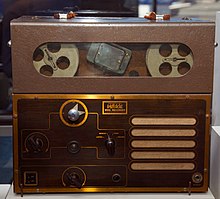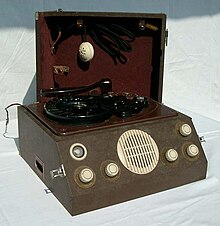Wireline recorder
A wire-tone device is used to store audio signals . The Danish physicist Valdemar Poulsen invented a device for storing tones on a steel wire around 1890, making it the first wire-tone device. He called the device the telegraphone .
A steel wire is led past an electromagnet. The electromagnet is connected to a microphone, which converts the sound waves into an alternating voltage and leaves a permanent magnetization in the steel wire through magnetic induction. If the magnetized steel wire is then led past the electromagnet again, an electrical voltage is induced in it, which makes the original signal audible in a loudspeaker connected to the electromagnet.
Wire-tone machines were quite widespread in the USA in the 1940s and 1950s; in Germany they only achieved minor importance. Here they were u. a. Used by the Deutsche Bundesbahn to record train reports. In the 1950s they were replaced by tape recorders . Only in flight recorders did they last a little longer.
In the 1930s, wires made of chromium-manganese steel (15% Cr, 12% Mn) were mostly used as wire material. The diameter was 0.11 mm for music and 0.22 mm for voice recordings. Later, the manganese was replaced by nickel (18% Cr, 8% Ni), and wires with a diameter of 0.09 mm were used as strength.
Web links
- Retro Tech: The Wire Recorder , YouTube , July 3, 2016
Individual evidence
- ↑ Aaron Foisi Nmungwun: Video Recording Technology Its Impact on Media and Home Entertainment . Routledge, 2012, ISBN 978-0-8058-0360-0 , pp. 38 ( limited preview in Google Book search).
- ↑ Article "Wire Recording" in the English language Wikipedia, see Wire Recorder .
- ^ David Wyatt, Mike Tooley: Aircraft Electrical and Electronic Systems . Routledge, 2009, ISBN 978-1-136-44435-7 , pp. 322 ( limited preview in Google Book search).
- ↑ Hans Sutaner: Record and tape. Fachbuchverlag Leipzig, 1954 (editorial deadline November 7, 1953).


